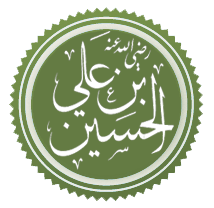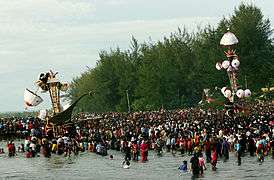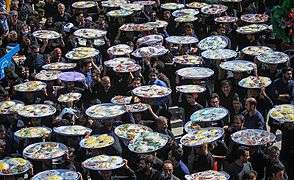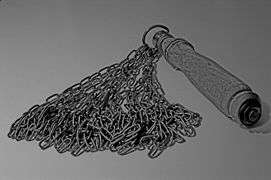Mourning of Muharram
| Mourning of Muharram | |
|---|---|
 | |
| Type | Islamic |
| Significance | Marks the death of Hussein ibn Ali (Shi'a Islam, Sunni Islam) |
| Observances | Mourn and derive messages from Hussein's Sacrifice (Shi'a Islam); Fasting (Sunni Islam) |
| 2015 date | October 14 |
| 2016 date | October 2 |
| 2017 date | September 21 |
| 2018 date | September 11 |
| A series of articles on |
| Husayn ibn Ali |
|---|
 Husayn ibn Ali in Islamic calligraphy
Husayn ibn Ali in Islamic calligraphy |
| Life |
| Remembrance |
|
| Perspectives |
|
|
The Mourning of Muharram, Remembrance of Muharram, or Muharram Observances, is a set of rituals associated with both Shia and Sunni,[1][2] which takes place in Muharram, the first month of the Islamic calendar. Many of the events associated with the ritual take place in congregation halls known as Hussainia.
The event marks the anniversary of the Battle of Karbala when Imam Hussein ibn Ali, the grandson of Muhammad, was killed by the forces of the second Umayyad caliph Yazid I at Karbala. Family members, accompanying Hussein ibn Ali, were killed or subjected to humiliation. The commemoration of the event during yearly mourning season, from first of Muharram to twentieth of Safar with Ashura comprising the focal date, serves to define Shia communal identity.[3] At present, Muharram observances are carried out in countries with a sizable Shia population.
Etymology
The words Azadari (Persian: عزاداری) which mean mourning and lamentation; and Majalis-e Aza have been exclusively used in connection with the remembrance ceremonies for the martyrdom of Imam Hussain. Majalis-e Aza, also known as Aza-e Husayn, includes mourning congregations, lamentations, matam and all such actions which express the emotions of grief and above all, repulsion against what Yazid stood for.[2]
Expression of grief with thumping of the chest by Shia Muslims is known as Latmya, Latmaya or latmia in Arabic-Persian countries. In India and Pakistan it is called Matam or Matam-Dari/Sina Zannee (chest beating).[4]
Muharram rituals was often called by European observers "the Feast of Hasan and Hosayn," as the participants shout "Hasan! Hosayn!."[1]
The term majalis has both a grammatical meaning and a meaning which relates to Aza-e-Husayn. In its technical sense, a majalis is a meeting, a session or a gathering.[5]
Background
According to Shia sources, The mourning of Muharram was started by the family, specially womenfolk, of Muhammad (the Ahl-ul-Bayt) immediately after the death of his grandson and even before entering Damascus.[6] Following the battle of Karbala, Muhammad's granddaughter Zaynab bint Ali and sister of Imam Husayn, began mourning for the fallen and making speeches against Imam Husayn ibn Ali's opponents: Ibn Ziyad and Yazid I. News of Imam Husayn ibn Ali's death was spread by Imam Zain-ul-Abideen, who succeeded Imam Husayn as the Shia Imam, via sermons and speeches throughout Iraq, Syria and Hejaz.[7]
Due to the History of the Prophets and Kings, when Ali ibn Husayn Zayn al-Abidin gave the sermon in presence of Yazid, he let them held mourning of Husain ibn Ali for three days in a formal manner.[8]
During the Umayyad Caliphate , the mourning of Husain ibn Ali’s Killing was performed furtively in the homes of shia Imam and their followers, but during the Abbasid Caliphate this mourning was observed in public mosques by the Abbasid rulers to draw a people’s attention .[6]

As Chelkowski said, in fourth century in Baghdad, contemporaneous with the reigns of Sulton Muizz ad-Dawla of the Shia Buyid dynasty the first public mourning ritual was happened and the market was closed by order of him on day of Ashura.[9] The mourning rituals evolved differently in different places, until the Safavid dynasty established a centralized Shia state in the 16th century:[10]:118 the annual mourning ceremonies and ritual cursing of Husayn's enemies, acquired the status of a national institution. According to popular belief, Shia rituals spread to South Asia starting at the end of the 14th century with the conquests of Tamerlane.[10]:120 Observance has since spread to countries such as India, Pakistan, Iraq, Iran, Turkey, Afghanistan, Syria, Nigeria, Tanzania, Saudi Arabia, Bangladesh, Yemen, Bahrain, Azerbaijan and Lebanon.[9][11][12]
Types
| |
|---|
 |
|
|
The type of mourning of Muharram varies between branches of Shia, Sunni, and different ethnic groups.[13]
Shia
Shia Muslims around the world every year commemorate the mourning custom of death of Husayn ibn Ali, his family and his follower in months of Muharram and Safar. They entitle him “Prince of Matyrs and know his as a spiritual and political savior. Still, he has important role in the religious and national consciousness of the people. According to the Shia belief taking part in the mourning ritual will be an help to salvation on day of judgment, as Elias Canetti (winner of Nobel Prize) said “became the very core of the Shiite faith ... of all the traditional religions of lament which could be adduced for closer consideration that of the Islamic is the most illuminating... The lament itself, as an impassioned pack opening out, to a true e crowd, manifests itself with unforgettable power at the Muharram Festival Shiites”.[9] At first the mourning ceremonies and custom have been done in the open air at the main thoroughfare of city of village, a major intersection in the bazaar and the yard of mosque, caravanserai and private house. After a while to protecting the mourner from the weather, the Hussainiya and the Tekyeh were built.[9]
Sunni
The event is observed by many Sunnis, but to a lesser extent, and as a time of remembrance, rather than mourning. The Nizam of Hyderabad/Deccan Mir Osman Ali Khan, was not only a Sunni Muslim and the famous powerful ruler of Hyderabad Deccan State till 1948 but also a great lover of Ahle Bait and promoter of Azadari.[13]
Custom
After almost 12 centuries, five types of major rituals were developed around the battle of Karbala. These rituals include the memorial services (majalis al-ta'ziya), the visitation of Husayn's tomb in Karbala particularly on the occasion of the tenth day of Ashura and the fortieth day after the battle (Ziyarat Ashura and ziyarat al-Arba'in), the public mourning processions (al-mawakib al-husayniyya or the representation of the battle of Karbala in the form of a play (the shabih), and the flagellation (tatbir).[6]
Pilgrimage to the shrine of Husayn
Imam Husayn Shrine is located at the mosqe and burial sites of Husayn ibn Ali, the third shia Imam in the city of Karbala, Iraq. Many Shia go on a pilgrimage to the Imam Husayn Shrine in Karbala, one of the holiest places for Shias apart from Mecca and Medina. Up to one million pilgrims visit the city annually to observe the anniversary of Imam Husayn ibn Ali's death.[14] shia Muslims believe that pilgrimmage to Husayn ibn Ali’s shrine like weeping saves them from condemned to hell at the day of judgment and all their guilt is removed.[15]
Matam
.jpg)
The Arabic term matam refers in general to an act or gesture of mourning; in Shia Islam the term designates acts of lamentation for the martyrs of Karbala.[16] Male and female participants congregate in public for ceremonial chest beating (matam) as a display of their devotion to Imam Husayn and in remembrance of his suffering.[17] In some Shi'a societies, such as those in Bahrain, Pakistan, India, Afghanistan and Iraq, male participants may incorporate knives or razors swung upon chains into their matam. There are two basic forms of matam:[18][19][20]
- matam using one's hands only, that is, sineh-zani or breast-beating
- matam with implements like chains, knives, swords and blades, that is, zanjeer-zani, qama-zani, etc.
Matam in South Asia is the most significant and sensitive Shia identity marker.[19]
Tatbir
Taziya
One form of mourning is the theatrical re-enactment of the Battle of Karbala. In Iran this is called taziya or taziyeh. Theatrical groups that specialize in taziya are called taziya groups.[21] Taziyas were popular through the Qajar dynasty until the early twentieth century, but the re-enactments slowly declined until they were mostly abandoned in the large cities by the early 1940s. Nonetheless, taziyas continued to exist in Iran on a smaller scale especially in more rural and traditional areas. Reza Shah, the first of the Pahlavi dynasty, had outlawed taziyas. Despite attempts since 1979, Muharram processions and various forms of the rawza khani are still more common.[22]
Noha
By increasing the number of shia Muslim in cities and states, mourning of muharram’s ritual changed to a more elaborate form. In the ninth century, lamentation and wailing became propounded as a mourning tradition. Noha is the poem and story that be inspired from Maqtal al-Husayn (various books which narrate the story of the battle of Karbala and the death of Husayn ibn Ali) .[6][23] The poet or another one read the noha with plaintive rhythm. The main subject of noha is the pain from the killing of Husayn ibn Ali. Noha consists of poems In different languages such as Arabic.[24]
weeping
The reaction of the audience in the reenactment of the battle of karbala’ episode is significant for strengthening of distinct shia identity and the weeping over the killing of Husayn ibn Ali and his follower is one of these reactions. There is close relation between the lamentation and weeping. According to the narration, shia Imams had emphasized to weep for them, so it had transmitted to future generation. Due to the tradition of shia the weeping and the flow of tears save mourner, When they condemned to hell.[6]
Processions
Depending on the condition of society, the Muharram processions changes from one city to another. The common form is the starting of mourning processions from Hussainiya and the participants would parade through the streets of their town or village, finally they come back to Hussainiya for performing other mourning of muharram’s ritual. The procession was common ritual’s mourning of dead persons in Arabic states before the appearance of Islam. The breast- beating, flagellation and face-slapping (latm) are usual acts doing during the mourning procession, but breast- beating and face-slapping (latm) have more precedence and the history of doing this acts had been reached to Buyid dynasty period.[6]
Flagellation
The acts of flagellation is the way for reenacting blood shedding of Husayn ibn Ali. The previous record of this act reaches to seventeenth century that had been done at Caucasus and Azerbaijan and nineteenth century that had been observed between the shia Twelver in central and southern cities of Iran and Arab world.[6] There were various types of flagellation including striking by chests with palms, striking backs with chains, beating foreheads with knives and swords.[9]
Rawda
Rawda is one of the shia Iranian mourning ritual to commemorate the death of Husayn ibn Ali and his follower. specially it is the kind of public lamentation. Rawda means garden in Arabic language and this name is acquired from the title of Rawdat al-Shuhada, literary masterpiece book authored by Husayn Waiz Kashifi in Persian. The word of Rawda-khawani means "recitation from Rawdat alshuhada" and generally is named Rawda. At first this ritual became customary on first ten days of Muharram, but by passing of time it was performed during Muharam and Safar and other days of year. Today, Rawda is either the story of Rawdat of al-Shuhada or stories that Rawḍa-k̲h̲ w ān (person who does the recitation) creates by his skills and knowledge to release the original text of book. This ritual can be held at every where such as houses, the yard of mosque, the square of city or village and also Hussainiya and the Tekyeh. The origin place of Rawda was Iran, but then at Bahrain this ritual is seen in its original form and at other place like India, the modified form of it is held.[25]
Alam
One of the most important and symbolic object used at mourning ritual is Alam. It is the ensign of Husayn ibn Ali in battle of Karbala and sign of the truth, bravery. The length of Alam is about 15 feet. Alam consists of flexible steel blades placed at upper part of it. Also Alam is decorated by plumes and fine embroidered silks and brocades.[9]
Nakhlis
Nakhlis is the symbol of Husayn ibn Ali's bier. Deta palm is the meaning of it in Arabic. During Modern age the date palm stretcher becomes an upright lattice shaped like a tear-drop and is a huge, so many people must carry it. Other kind of Nakhlis are small and just two people can move it. The Nakhle through special ritual is decorated one night before the procession by mirrores, brocades, rugs, sword and other military equipments. This symbol is commonly used at the city of Yazd in Central part of Iran and its surrounding villages.[9] people move the coffin of Husain Ali by cring loud “ya Husain”.[26]
Around the world
In South Asia, literary and musical genres produced by both Shias and Sunnis, that have been inspired by the Battle of Karbala are performed during the month, such as marsiya, noha and soaz. This is meant to increase the peoples understanding of how the enemies fought The Battle of Karbala against Husayn and his followers. In Trinidad and Tobago and Jamaica[27] all ethnic and religious communities participate in the event, locally known as "Hosay" or "Hussay". In Indonesia, the event is known as Tabuik (Minangkabau language) or Tabut (Indonesian).[28]
Gallery



 Nakhl gardani in Mehriz, Yazd, Iran.
Nakhl gardani in Mehriz, Yazd, Iran..jpg) Nakhl gardani in Iran.
Nakhl gardani in Iran..jpg) Mourning of Muharram in Iran.
Mourning of Muharram in Iran. The Muharram, 1795: Asaf al-Daula, Nawab of Oudh, listening at night to the maulvi reading from the scriptures during Muharram, c.1795.
The Muharram, 1795: Asaf al-Daula, Nawab of Oudh, listening at night to the maulvi reading from the scriptures during Muharram, c.1795._procession_Barabanki_India_(Jan_2009).jpg)

 Matam procession in Malir, Pakistan.
Matam procession in Malir, Pakistan. Zanjir(Chain) used for Zanjir matam.
Zanjir(Chain) used for Zanjir matam. Muharram mourning in Qom, Iran.
Muharram mourning in Qom, Iran. People lighting candles at the night of Ashura in Tehran, Iran.
People lighting candles at the night of Ashura in Tehran, Iran.
See also
- Tatbeer or Qama Zani and Zanjeer zani
- Marsia
- Noha
- Soaz
- Ta'zieh
- Hussainia
- Hosay
- Carpet Washing Ceremony
- Holy Week, a week-long festival of mourning for the death of Jesus observed by Roman Catholics.
- List of casualties in Husayn's army at the Battle of Karbala
- Azadari in Lucknow
- Rawda Khwani
Notes
- 1 2 Calmard, Jean (2012). "ḤOSAYN B. ʿALI ii. IN POPULAR SHIʿISM". Iranica.
- 1 2 Jean, Calmard (2011). "AZĀDĀRĪ". iranicaonline.
- ↑ Martín, Richard C. (2004). Encyclopedia of Islam & the Muslim World. Macmillan Reference USA. p. 488.
- ↑ "Latmiyat". definithing.com.
- ↑ Rahimi, Babak (2011). A History of (Safavid) Muharram Rituals. BRILL. ISBN 9789004207561.
- 1 2 3 4 5 6 7 Nakash, Yitzhak (1 January 1993). "An Attempt To Trace the Origin of the Rituals of Āshurā¸". Die Welt des Islams. 33 (2): 161–181. doi:10.1163/157006093X00063. Retrieved 17 July 2016. – via Brill (subscription required)
- ↑ Nafasul Mahmoom. JAC Developer. pp. 12–. GGKEY:RQAZ12CNGF5.
- ↑ al-Tabari, Muhammad ibn Jarir. Tarikh al-Tabari. 4. p. 353.
- 1 2 3 4 5 6 7 Chelkowski, Peter (1 January 1985). "Shia Muslim Processional Performances". The Drama Review: TDR. MIT Press. 29 (3): 18–30. doi:10.2307/1145650. JSTOR 1145650.
- 1 2 Cornell, Vincent J. (2007). "The Passion of 'Ashura in Shiite Islam". Voices of Islam: Voices of the Spirit. Greenwood Publishing Group. ISBN 978-0-275-98734-3.
- ↑ Claus, Peter J.; Diamond, Sarah; Mills, Margaret Ann. South Asian Folklore: An Encyclopedia : Afghanistan, Bangladesh, India, Nepal, Pakistan, Sri Lanka. Taylor & Francis. ISBN 9780415939195. Retrieved 18 July 2016.
- ↑ Akhtar, Iqbal. The Khōjā of Tanzania: Discontinuities of a Postcolonial Religious Identity. BRILL. ISBN 9789004292888. Retrieved 18 July 2016.
- 1 2 Syed Hashim Razavi, Hyderabad, India. "The King Who Loved Azadari of Imam Husain". Imam Reza Net. Retrieved Feb 25, 2015.
- ↑ Shimoni, Yaacov (1974). Political dictionary of the Middle East in the 20th century. New York Times Book Co. p. 160. ISBN 978-0812904826.
- ↑ Scot Aghaie, Kamran (2004). The Martyrs of Karbala: Shi'i Symbols and Rituals in Modern Iran. University of Washington Press. p. 58. ISBN 978-0295984551.
- ↑ Shīʻite Heritage: Essays on Classical and Modern Traditions By Lynda Clarke, Global Academic Publishing, 01-Jun-2001
- ↑ Mullahs on the Mainframe: Islam and Modernity among the Daudi Bohras By Jonah Blank, University of Chicago Press, 15-Apr-2001
- ↑ Pinault, David (15 Aug 1993). The Shiites. Palgrave Macmillan.
- 1 2 Reliving Karbala: Martyrdom in South Asian Memory By Syed Akbar Hyder, Oxford University Press, 01-Sep-2008
- ↑ Sharing the Sacred: Practicing Pluralism in Muslim North India By Anna Bigelow, Oxford University Press, 28-Jan-2010
- ↑ Chelkowski, Peter (ed.) (1979) Taʻziyeh, ritual and drama in Iran New York University Press, New York, ISBN 0-8147-1375-0
- ↑ Martin, Richard C. (ed.) (2004) "Taziya" Encyclopedia of Islam and the Muslim World Macmillan Reference USA, New York, p. 691 ISBN 0-02-865912-0
- ↑ Puchowski, Douglas (2008). The Concise Garland Encyclopedia of World Music, Volume 2. Routledge. ISBN 978-0415994040.
- ↑ Fakhr Rohani, Ph.D, Muhammad Reza (2010-05-18). Ashura Poems in English Explained and Annotated (Volume 1) (2006 ed.). Al-Hassanain(p) Network Imam Hussain(p) Foundation. pp. 1–2(Forewords).
- ↑ Chelkowski (2012). Encyclopaedia of Islam. Brill. ISBN 9789004161214.
- ↑ Abu-Laban, Sharon; Qureshi, Regula; Professor Waugh, Earle (1991). Muslim Families in North America. The University of Alberta Press. p. 118. ISBN 978-0888642257.
- ↑ Shankar, Guha (2003) Imagining India(ns): Cultural Performances and Diaspora Politics in Jamaica. Ph.D. Dissertation, University of Texas, Austin pdf
- ↑ Bachyul Jb, Syofiardi (2006-03-01). "'Tabuik' festival: From a religious event to tourism". The Jakarta Post. Retrieved 2007-01-27.
Further reading
- Aghaie, Kamran S. (2004). The Martyrs of Karbala: Shii Symbols and Rituals in Modern Iran. Univ. of Washington Press.
- Aghaie, Kamran S. (2005). The Women of Karbala: Ritual Performance and Symbolic Discourses in Modern Shi'i Islam. Univ. of Texas Press.
- Beeman, William O. (2010). Iranian Performance Traditions. Mazda Press.
- Chelkowski, Peter J. (2010). Eternal Performance: Ta'ziyeh and Other Shiite Rituals. Seagull Books.
- Chelkowski, Peter J. (1979). Ta'ziyeh: Ritual and Drama in Iran. New York University Press & Soroush Press.
- Homayouni, Sadegh (2002). Ta'ziyeh in Iran. Navid Publishers.
- Malekpour, Jamshid (2004). The Islamic Drama. Routledge Press.
- Riggio, Milla Cozart (1994). "Ta'ziyeh in Exile: Transformations in a Persian Tradition". Comparative Drama. 28: 115–140. Reprinted in European volume (1997)
- Riggio (1988). Ta'ziyeh: Ritual and Drama in Iran. Trinity College Press.
External links
| Wikimedia Commons has media related to Mourning of Muharram. |
- Is Mourning of Muharram permissible?
- Description of breast beating portion of Muharram mourning ceremonies
- Azadari is a Way of Life
- A Brief Introduction to Majalis and Azadari
_procession_Barabanki_India_(Jan_2009).jpg)